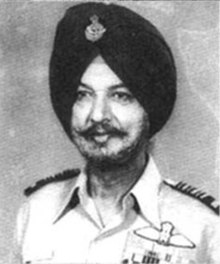Dilbagh Singh
Appearance
Dilbagh Singh | |
|---|---|
 | |
| Born | 10 March 1926 Shakargarh Gurdaspur district Punjab |
| Died | 9 February 2001 (aged 74) Dehradun, Uttarakhand, India |
| Allegiance | |
| Service | |
| Years of service | 1945-1984 |
| Rank | Air Chief Marshal |
| Unit | No. 1 Squadron |
| Commands | Eastern Air Command Ambala Air Force Station 28 Squadron[1] |
Air Chief Marshal Dilbagh Singh, PVSM, AVSM, VM (10 March 1926 – 9 February 2001) was the head of the Indian Air Force from 1981 to 1984,[2] as Chief of the Air Staff. He was the second Sikh to hold that position.
Dilbagh Singh was commissioned as a pilot in 1944.[3] His operational flying career spanned the Spitfire to introducing the MiG-21 into service in India. He had earlier made the first official "Supersonic Bang" over India in New Delhi when the Mystere IV-A was showcased in a public demonstration.
He was India's Ambassador to Brazil from 1985 to 1987.
References
- ^ "Air Marshal Kumaria Visits Air Force Station Chandigarh To Felicitate its 50 Golden Years". 1 March 2011.
- ^ "Dilbagh Singh". Bharat Rakshak. Retrieved 8 April 2018.
- ^ "rediff.com: Air Chief Marshal Dilbagh Singh no more". www.rediff.com. Retrieved 28 May 2020.
External links
Categories:
- Indian aviators
- Chiefs of Air Staff (India)
- Indian Air Force air marshals
- 1926 births
- 2001 deaths
- Indian Sikhs
- Military personnel from Punjab, India
- Ambassadors of India to Brazil
- Recipients of the Param Vishisht Seva Medal
- Recipients of the Ati Vishisht Seva Medal
- Indian Air Force officers
- Indian military personnel stubs

